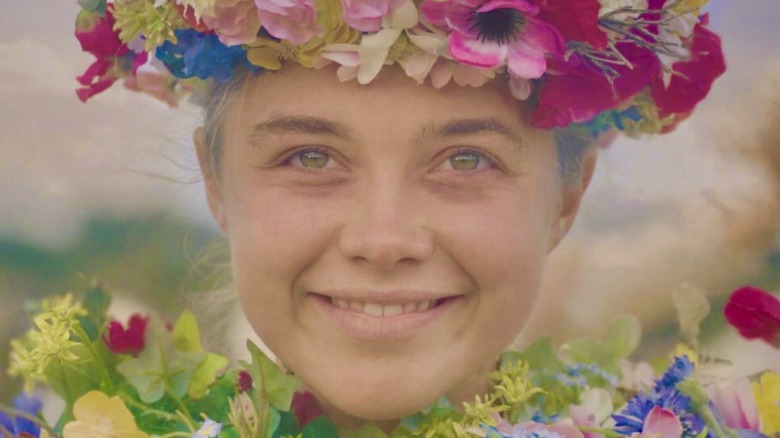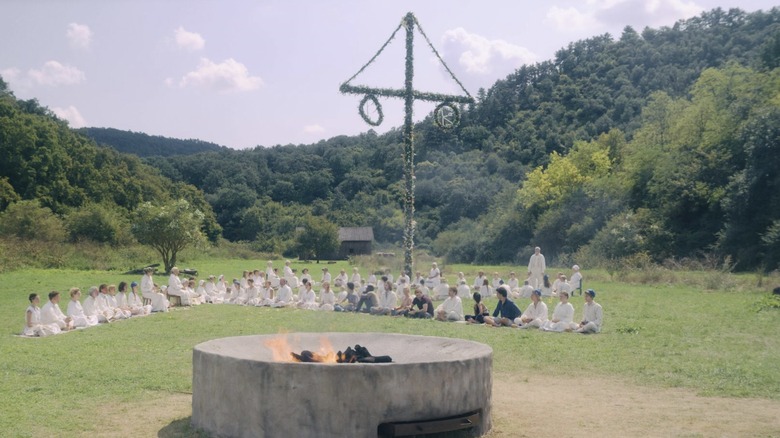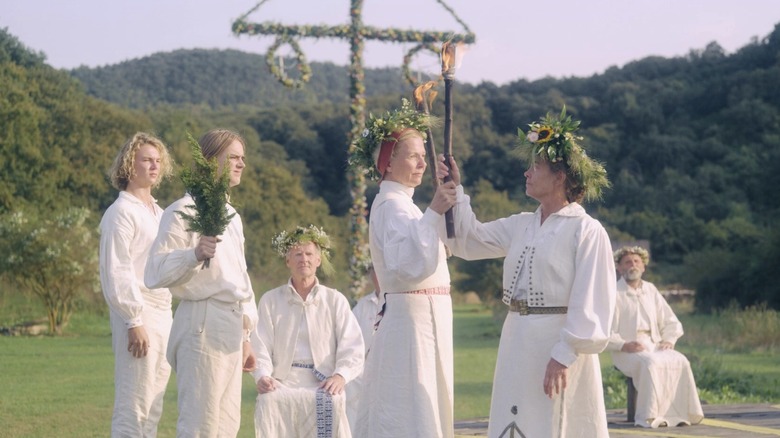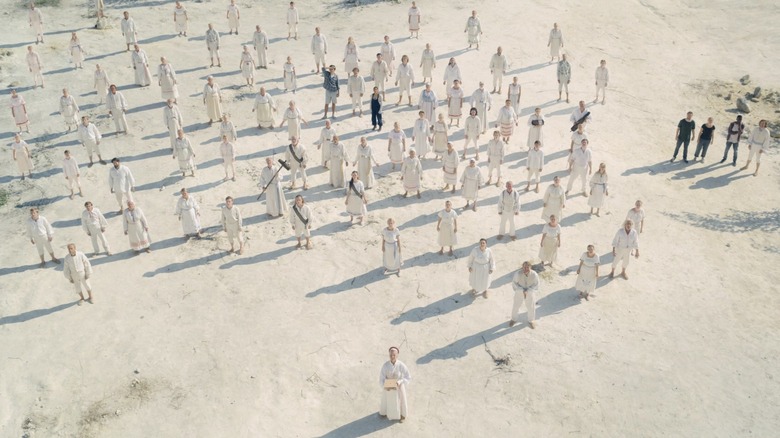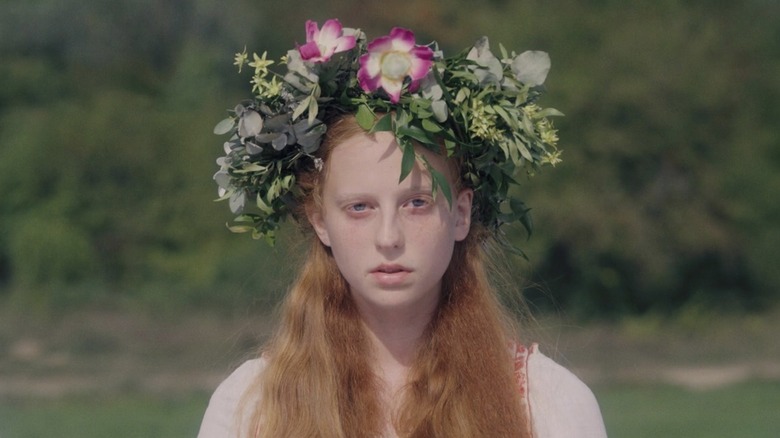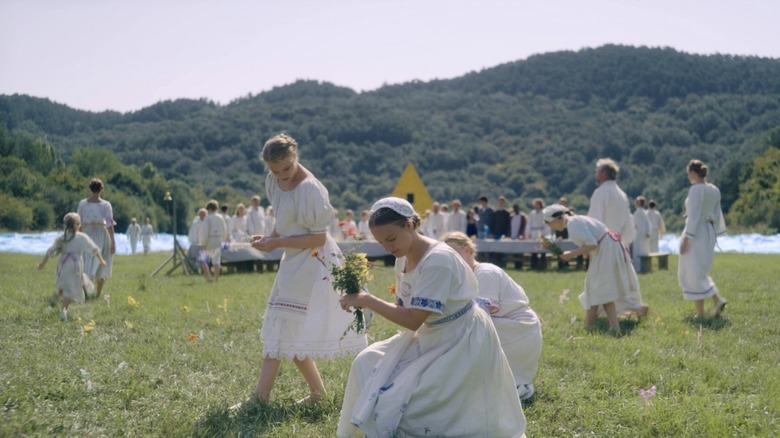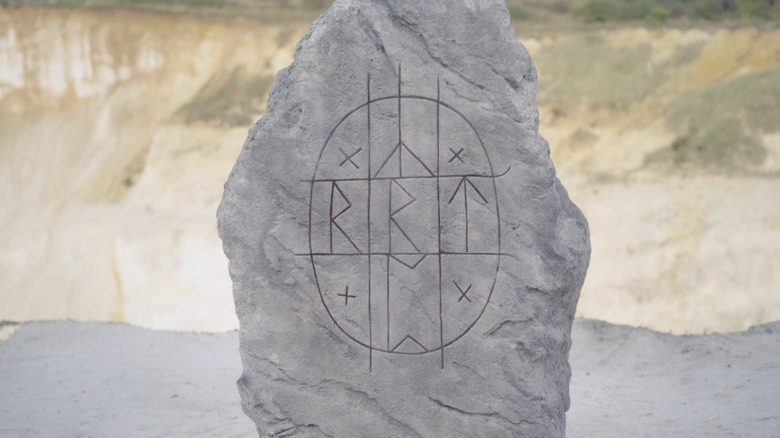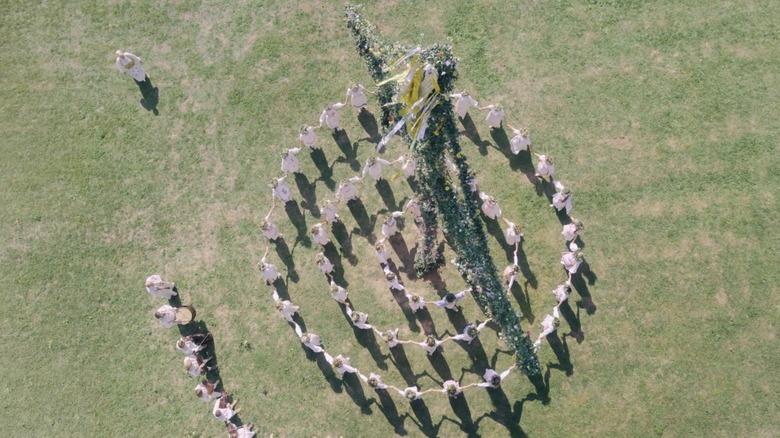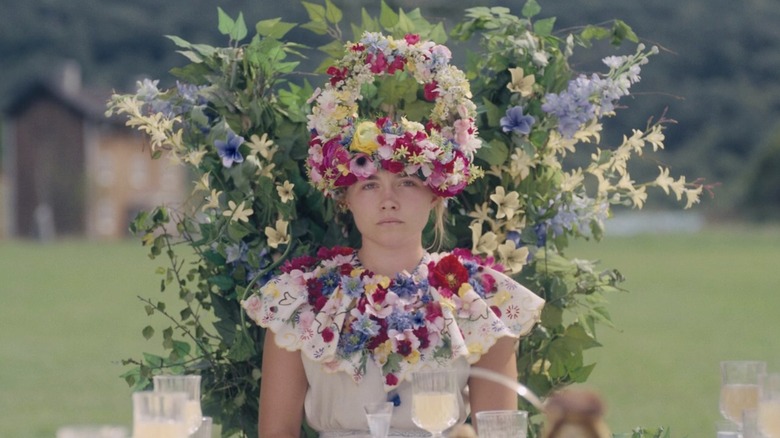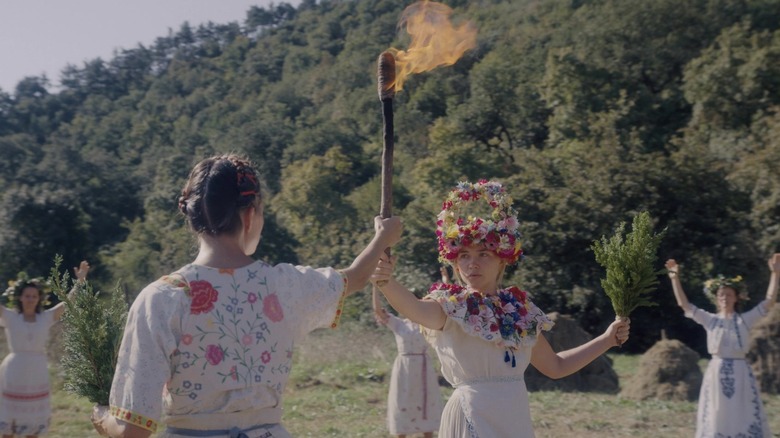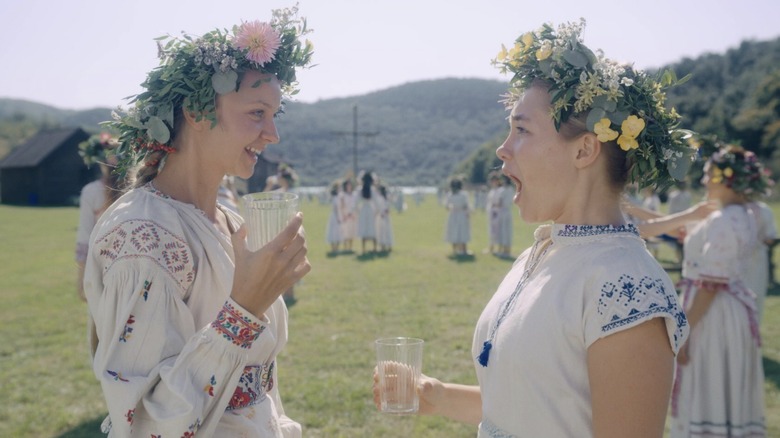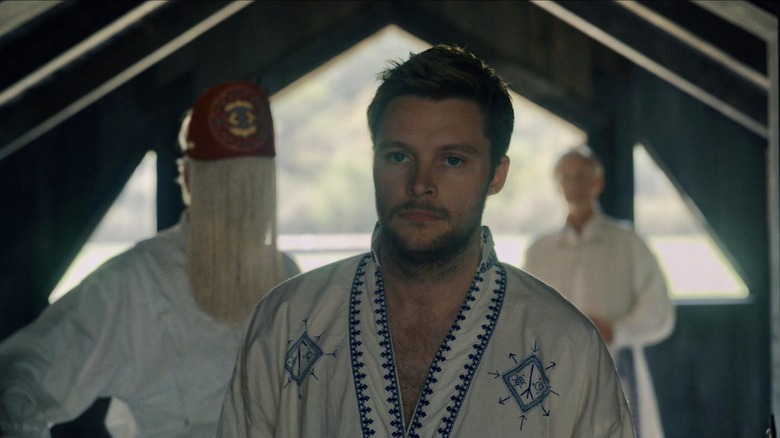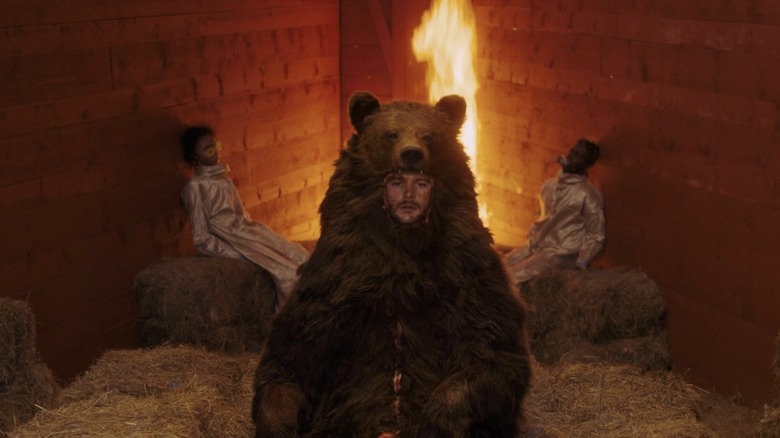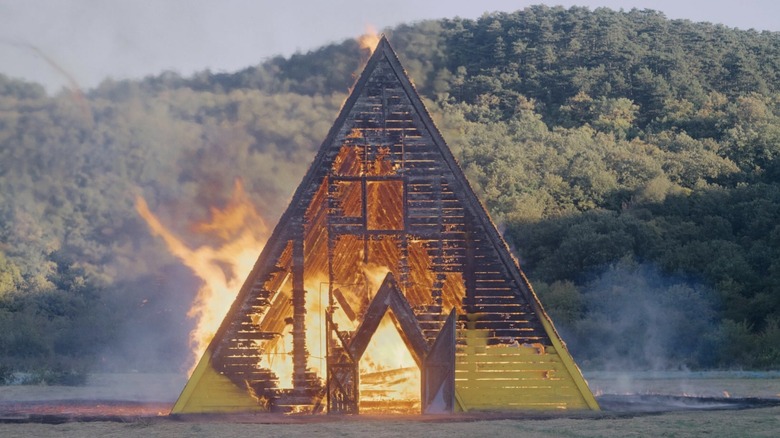Everything Midsommar Gets Wrong About The Real Festival
Writer-director Ari Aster's folk horror film "Midsommar" is about a summer vacation that goes horribly awry. A group of American graduate students — Christian (Jack Reynor), Josh (William Jackson Harper), and Mark (Will Poulter) — travel to the home of their friend Pelle (Vilhelm Blomgren): Hårga, a remote commune in Sweden . This vacation was originally planned as a boys' trip, but after Christian's girlfriend Dani (Florence Pugh) falls into a deep depression when her family dies in a tragic murder-suicide, Christian invites Dani along in a half-hearted attempt to save their doomed relationship.
The bucolic green meadows of Hårga greet them, the endless Scandinavian sunshine enchants, and friendly people dressed in gauzy white clothing embrace the visitors, all of which gives the commune an ethereal, inviting vibe. The group feels honored to observe this community's Midsummer traditions. But once the rituals begin, the visitors start to wonder if they have made a terrible mistake, as the residents of this sunny and idyllic Swedish commune reveal themselves to be a death cult, who practice blood rituals and human sacrifice.
After watching this hypnotic horror film, you may have wondered how closely the customs depicted in "Midsommar" resemble the real Midsummer festivals in Sweden. While Aster did take his inspiration for the religious practices of Hårga from some Swedish traditions, he also looked at British and German Midsummer rituals, and other spiritual movements to create something new (per The NY Times). So, stick with us as we separate the real traditions of Swedish Midsummer festivals from those depicted in the film, and reveal everything that "Midsommar" got wrong.
Warning: Spoilers ahead.
Sweden's Midsummer festivals are considered a Christian holiday
While the rituals and traditions represented in "Midsommar" have an ominous vibe and pagan roots, according to Jonas Engman from Nordic Museum's Department of Cultural History, modern Midsummer "is a celebration of St Johannes (St John) — it's a Christian holiday that probably entered Sweden when we became Christians in 10th or 11th century" (per Elle). Engman explained that despite having religious origins, however, Midsummer has been embraced as a secular celebration that's popular throughout Sweden regardless of religious affiliation, saying, "it is one of the most celebrated holidays in our country."
We often celebrate Christian holidays around the same time of year as ancient pagan festivals, which suggests that these Christian holidays also have pagan origins. In Sweden and other Scandinavian countries, the Catholic Church found it easier and more useful to just take over pagan festivals, rather than try to erase or stop them completely (per Real Scandinavia). Midsummer is celebrated near the summer solstice, much in the same way that Christmas is celebrated near the winter solstice, and in this way, Christian celebrations can envelop pagan rituals and roots.
In "Midsommar," the residents of Hårga did not get the memo and clearly observe the Midsummer festival from a pagan perspective: They incorporate pre-Christian practices and rituals, and celebrate the fertility of the land and the energy of the sun. However, if you visit Sweden to enjoy their Midsummer festivals, you needn't worry about mysterious pagan rites, ritual sex, human sacrifices, or cults. Midsummer is a joyful and light-spirited family holiday that's spent in the countryside, where you can enjoy plentiful sunshine, food, and drink with family and friends, as summer begins.
Midsummer celebrations only last a few days
In "Midsommar," the Hårga commune's Midsummer festival is presented as a nine-day celebration of feasts and rituals. We learn that it has been 90 years since their last great feast, which is a cleansing ritual. This suggests that not all the rituals we see depicted are practiced within the community annually during their Midsummer celebrations.
In reality, Swedish Midsummer festivals were traditionally observed on June 24th each year to celebrate the feast day of St. John the Baptist. According to Real Scandinavia, in 1952, the Swedish Parliament declared Midsummer should always take place on the weekend closest to the summer solstice (June 21st). So, in reality, Swedish Midsummer celebrations are just one weekend of feasting and revelry, rather than a nine-day event.
One of the brilliant aspects of "Midsommar" — and why it is such a successful representation of folk horror — is that the community of Hårga is depicted as being separate from traditional Swedish culture. This gives writer-director Ari Aster the freedom to create a community with rituals and beliefs outside the norm for both modern Sweden and American audiences to create something new, which is still "tethered to something real," as he told The New York Times. Where this film really shines is how — despite showing us the horrors that Dani and the other outsiders experience at Hårga — we also see the beauty of these celebrations, as well as the empathy and interconnectedness of this community.
There are no Ättestupa ritual suicides in Swedish Midsummer festivals
One of the most shocking sequences in "Midsommar" is the Ättestupa suicide ceremony that Dani, Christian, and Josh witness soon after arriving to Hårga. Pelle explains the life cycles of Hårga residents earlier in the film. Spring is childhood until you turn 18, summer lasts until 36, fall is working-age until 54, and then you become a mentor until you are 72. When Dani asks, "What happens after 72?" Pelle jokingly makes a motion of cutting his neck.
Later, Dani and the others discover what happens after 72: Two elders take part in a ritual suicide, jumping off a towering rock to the ground, where their community waits below. In Hårga, this Ättestupa ceremony is seen as one of honor, although Dani and the other visitors are disturbed to varying degrees. Josh approaches the Ättestupa ceremony from an anthropological and scholarly distance, while Christian attempts to keep an open mind, but is visibly shaken. Dani, however, is still grieving after suffering the loss of her family, and is re-traumatized by watching the Ättestupa ceremony.
Po Tidholm, a Swedish journalist and authority on Swedish traditions, told Matt Miller in an interview with Esquire, "to my knowledge there [have] never been any sacrifices on midsummer. Not even in ancient times." Although Ättestupa rituals are part of Swedish and Norse mythology and folktales, their practice in reality has long been disputed. Sweden's Consul General Annika Rembe told The Ringer via email, "Historians today agree Ättestupa never existed in real life but it is a myth inspired by a story in the medieval Icelandic saga 'Gautreks saga' set in Sweden."
If you or anyone you know is having suicidal thoughts, please call the National Suicide Prevention Lifeline at 1-800-273-TALK (8255).
Pubic hair pie is not a traditional Swedish love charm
In "Midsommar," Hårga resident Maya takes a liking to Christian, who becomes the recipient of some hard-to-swallow folk love charms. We see some elaborate artwork in Hårga, which shows the distinct steps a woman must take to enchant a man into loving her. Maya begins her campaign to win Christian by carving a love rune and placing it under his bed (as shown in the artwork), and she soon moves on to the next steps seen in the banner.
Matt Miller of Esquire suggests pubic hair pie is actually a Medieval love spell, while Jonas Engman from Nordic Museum's Department of Cultural History told Elle, "Young girls could use all kinds of magic techniques in order to foresee who they hopefully would marry in the future or to make a boy fall in love. One of them was to put your urine (not much!), menstrual blood, or sweat in the boy's coffee, water, or whatever they would drink. But these magical techniques were not associated exclusively with Midsummer."
According to Real Scandinavia, "A Swedish verse says, 'Midsummer night is not long, but it sets many cradles to rock.'" So, while Swedish Midsummer does have associations with love, fertility, and the magic of nature, the love spells that Maya puts on Christian are used to further the plot of the film more than accurately represent Swedish Midsummer traditions. After all, as Swedish journalist and scholar Po Tidholm notes to Esquire, the romance of Midsummer is more tied to the consumption of alcohol than the use of love spells.
The film doesn't explore the Midsummer flower-picking tradition
In "Midsommar," we see girls picking flowers while walking backwards, but never learn the purpose or significance of this practice. The truth is, spring comes late to Sweden, so wildflowers are at their peak in Midsummer, and picking flowers for crowns and love charms is part of the Swedish Midsummer tradition. As reported by Newsweek, during Swedish Midsummer, girls and young women pick seven (or sometimes nine) different varieties of flowers, and put them under their pillow, so they will see the face of the person they will marry in their dreams.
Although "Midsommar" doesn't offer this information to the audience, there are hints about it throughout. At one point, Pelle tells his friends that children learn about the runes by carving them and sleeping with them under their pillows, so they will dream about the runes' meaning. We later see Maya place a love rune under Christian's bed. Likewise, we also see one of the young women place a pair of scissors under the pillow of a crying baby, which is a folk charm to ward off nightmares.
You may have also noticed the artwork on the banner depicts this ritual of picking flowers as one of the beginning stages of the love charm, which Maya uses on Christian. The banner shows a young woman picking flowers while walking backwards and then placing them under her pillow. So, while this real-life tradition is alluded to in the film, "Midsommar" doesn't show it fully enough for viewers to grasp its meaning.
Ancient Norse runes have nothing to do with Swedish Midsummer traditions
Norse runes are prominently featured in "Midsommar." They are embroidered into the folk costumes the residents of Hårga wear for the festivities. Runes are carved into sticks and stones. We see them painted in elaborate murals on the walls of the buildings of the commune. When looking down on Hårga from an aerial view, we even see Norse runes in the formations of people sitting together and in the arrangement of dining tables.
There are different ways of translating runes, and the ones in the film fall under the more mystical and occult style of "Uthark" (per Thrillist). Director Ari Aster even learned to read Norse runes in preparation for making the film, going so far as creating an "Affekt language ... which is a melange of folklore, historical fact, tradition and invention." This language is used for the songs throughout the film, and as Aster told The Ringer, "It's akin to singing in tongues."
Norse runes exist in Sweden, as they do in Norway and Denmark, and connect the people of these Scandinavian countries to their Viking heritage, but they are not part of the traditions associated with modern Midsummer festivals in Sweden. Jonas Engman from the Nordic Museum's Department of Cultural History told Elle, "Until approximately the early 19th century, some people in a few areas of Sweden used runes on a wooden stick as a kind of magical diary. The magic was mostly connected to farming practices," suggesting this practice has lost its popularity and is not part of Swedish Midsummer traditions.
There is no Maypole dance competition in Midsummer
Maypole dancing happens at Swedish Midsummer festivals, so the inclusion of this in "Midsommar" is accurate. Journalist and Swedish tradition expert Po Tidholm told Elle, "The Swedish midsommarstång, or maypole, is said to be of German, Christian heritage." Dancing around the Maypole is a pagan custom that originally was celebrated on May 1st or May Day, and involves decorating a pole with ribbons, flowers, and greenery, to represent a tree (per Learn Religions). This goes back to the practice of ancient people dancing around real trees, as this was believed to bring in a large crop harvest.
According to Real Scandinavia, dancing around the Maypole is a newer tradition in Swedish Midsummer celebrations, which came directly from Germany. However, since spring comes to Sweden later than in Germany, there wasn't enough greenery to cover the pole at the beginning of May, and so the Maypole ritual was pushed to Midsummer instead. As Tidholm explained to Elle, "Dancing is a way to make Midsummer fun for kids."
While the Maypole is part of Swedish Midsummer traditions, the dance competition shown in "Midsommar" is not. As explained in the film, the Maypole dance competition in Hårga is in defiance of the "Black One." According to Tidholm, this dancing is probably inspired by an old myth from his home province, Hälsingland: The devil disguised himself as a fiddler, and lured young people to dance till they died, as described in the film. However, according to Tidholm, "the tale has, to my knowledge, no connection with Midsummer" (per Elle).
A May Queen is not part of Swedish Midsummer
While dancing around the Maypole is a modern Midsummer tradition (although pagans dispute that it is a Christian tradition imported from Germany), the crowning of a May Queen — as seen in "Midsommar" — is not. The May Queen does come from customs tied to May Day celebrations, in which the May Queen represents the fertility and regeneration of Spring (per The British Newspaper Archive).
Jonas Engholm told Elle that the use of the May Queen in the film "has to do with a vernacular custom to install a local May Queen to walk around the village in a procession in the spring. I'm not aware of any May Queens nowadays." As Aster told The Ringer, "Obviously we took great liberties with the things we were drawing from."
The entire film is a cathartic experience for Dani, whose emotional experience is at the heart of "Midsommar." The May Queen dance competition brings Dani into the fold at Hårga because ultimately, Pelle wanted Dani to come to Hårga to welcome her into a family. Aster echoed this sentiment when he told The Atlantic, "Hopefully, the details are rich, and there's a logic behind everything the villagers are doing, and they're not just lawless pagans. At the same time, they're also adhering to laws that are very particular to this film, and they exist solely to satisfy Dani's particular needs. They are perfect for Dani right now. It's a wish-fulfillment film in a way — she loses a family and gains one."
The May Queen doesn't bless the crops and livestock
In modern Swedish Midsummer festivals, there is no May Queen at all, let alone one to bless the crops and livestock. But in Aster's "Midsommar," after being crowned May Queen, Dani is taken in a chariot to give her blessing to the land and animals of Hårga. In the film, the ritual is shown as one of burying meat, grain, and an egg, which is followed by singing and holding a torch in a fertility ceremony. These are not customs of Swedish Midsummer celebrations, but rather seem to be a melange of Beltane festivities and those practiced for Ostara to welcome spring at the vernal equinox.
While there are some practices tied to the May Queen that are meant to bring in a bountiful harvest — such as carrying boughs and branches from home to home — human sacrifice has not been confirmed to be one of them (per Learn Religions). Pop culture and films like "The Wicker Man" may show the May Queen offered as a sacrifice to ensure abundance, but Aster subverts this trope at the end of "Midsommar." Dani is given the responsibility of choosing the last sacrifice for the purification ritual, and in doing so, she taps into her full power as the May Queen and cements her status as a new member of the Hårgan community.
Swedish Midsummer traditions don't use psychedelics
In the film, the commune uses psychedelics to lower the inhibitions of the outsiders, who witness this Midsummer festival. Psychedelics are used ritually in Hårga: Drinking a hallucinogenic tea is part of the Maypole dance ceremony, as the contestants (and Christian) sip on a drink described as "spring water with special properties" to "break down your defenses and open you up to the influence." Swedish traditions expert Po Tidholm told Esquire, "As far as drugs go, Swedes have had — like most nordic people — a tendency to drink a bit too much on festive occasions. But that's it."
While the use of psychedelics is not part of modern Swedish Midsummer traditions, the incorporation of psychoactive plants into Hårga's customs isn't unrealistic. Archeological and scholarly research has shown that psychoactive plants have been used throughout history in many cultures during religious or pagan rites as a way of accessing altered states (per NeuroQuantology). So, it isn't surprising that a pagan and nature-based community like Hårga would use these substances during their rituals.
It also isn't surprising that a filmmaker as meticulous as Ari Aster would be able to capture the psychedelic experience, as Jack Reynor (Christian) noted to The Los Angeles Times, "Can you think of any film that you've watched that has as accurately represented the experience of a mushroom trip? ... I felt like by and large, all of the performances really hit the right beats of what it's like to be under the influence of mushrooms."
Ritual sex is not a part of Swedish Midsummer
Once Maya sets her sights on Christian, his fate is sealed. After all, the visitors aren't just in Hårga to be sacrificied, but also to expand the gene pool of this isolated community. This element of ritualistic sex in the film probably comes from the pagan fertility rites associated with goddess of spring Ostara (whose worship and rites later turned into Easter) and Beltane, but not Midsummer festivities.
The practice of ritual sex also heightens the cultish elements of the Hårga: Everything is arranged by community elders, who tell Christian that his zodiac chart is compatible with Maya, and effectively bless their union. As writer-director Ari Aster pointed out to Thrillist, "They're not the most diverse community," which indicates it might be intentional that the only visitors who live long enough to procreate during ritual sex or become May Queen visually blend into the ethnically homogenous Hårgan community.
This isn't to say that sex is totally absent from Swedish Midsummer, since the Maypole — universally recognized as a phallic symbol — and the custom of girls picking flowers to divine their future partner suggest that Midsummer celebrations do have an amorous vibe. Po Tidholm told Elle, "Since people get drunk on Midsummer, they also tend to have sex with people they shouldn't have sex with. That, and the romantic feel of a beautiful and long night when the sun almost doesn't set, used to make March 22, nine months after Midsummer, the day when the most babies were born in Sweden," before adding this isn't the case anymore.
Midsummer festivals in Sweden do not practice human sacrifices!
The ritual sacrifice of humans (or bears) is historically not a part of Swedish Midsummer customs, so that fiery temple in the last scene of "Midsommar" is really just a dramatic climax for the film. Jonas Engholm of the Nordic Museum's Department of Cultural History told Elle, "It's possible, of course — there are some archeological findings in Denmark and Sweden that suggest that people were sacrificed. But this has nothing to do with Midsummer, as far as we are able to conclude."
Despite Swedish Midsummer celebrations not including human sacrifices, Ari Aster's decision to place Christian in the hollowed-out carcass of a slaughtered bear was inspired by Norse mythology. Aster told The Ringer, "The bear holds certain significance in Norse mythology, and I was sort of drawing from that." That mythological significance comes from the Viking "berserkers," who dressed in bearskins and went into blood-thirsty trance-like states during battle. Regardless, you will be hard-pressed to find bear carcasses or human sacrifice at a Swedish Midsummer celebration.
The ritual burning of the temple isn't realistic
Bonfires may have been a traditional part of numerous midsummer festivals, but they aren't a prominent aspect of modern Swedish Midsummer traditions. As Newsweek points out, "Some older, more explicitly pagan rituals, have been lost from the Swedish Midsummer tradition, such as the rolling of burning wheels down hills, which has been traced back to the 4th century." However, in Norway, summer is still ushered in with a huge bonfire known as Slinningsbålet (per Business Insider).
The use of a bonfire in "Midsommar" is probably borrowed from other pagan cultures, like those celebrating the Celtic Wheel of the Year, where building a bonfire is customary when celebrating Litha. Using fire for purification is common in many cultures, so Aster incorporating this use of fire into the ritual in Hårga is both visually and symbolically powerful.
At the beginning of this purification ceremony, before the fire is started, the people of Hårga speak the words: "With you, we purge our most unholy affects. We banish you now to the deepest recesses, where you may reflect on your wickedness." This incantation brings to mind the ancient scapegoat rituals that were used to purge a community of their shared sins, ensuring luck and prosperity for the future. Although this type of ritualistic purification through fire has nothing to do with Swedish Midsummer, it certainly fits within the fictional Hårgan community Aster created for "Midsommar."
